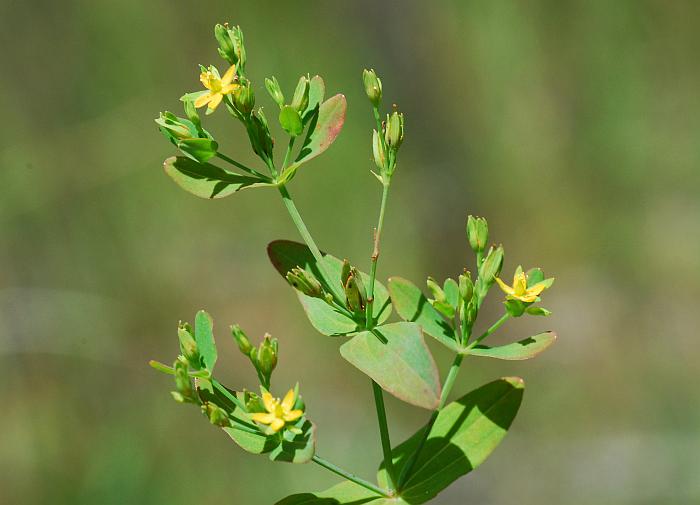Hypericum mutilum L.
Dwarf St. John's-Wort

Native
CC = 4
CW = -3
MOC = 78
© SRTurner
Hypericum mutilum L.Dwarf St. John's-Wort | |
 |
Native CC = 4 CW = -3 MOC = 78 |
© SRTurner |
|
Family - Hypericaceae Habit - Annual or short-lived perennial forb, fibrous rooted, sometimes with a rhizomelike creeping basal portion of the stem, this rooting at the nodes. Stems - Loosely ascending to erect, to 90 cm, rounded or inconspicuously angled or ridged below each leaf, green.
Leaves - Opposite, often decussate, sessile. Leaf blades 4-40 mm long, 1-15 mm wide, lanceolate, ovate, or elliptic, rounded or bluntly pointed at the tip, broadly angled to rounded or shallowly cordate at the base, often somewhat clasping and crowding the stem, the margins flat, membranous to herbaceous in texture, with mostly 3 or 5 main veins from the base, the surfaces with inconspicuous, minute, yellowish brown to dark green or black resinous dots, the upper surface green, the undersurface somewhat paler, not glaucous.
Inflorescence - Panicles of 5-60 flowers at branch tips, usually more or less rounded in outline, sometimes reduced to small clusters of flowers at the branch tips.
Flowers - Actinomorphic. Sepals 5, all similar in size and shape, 2-4 mm long, usually becoming slightly enlarged at fruiting, linear-lanceolate to narrowly oblong-lanceolate, lacking noticeable yellowish brown or black dots, lines, and/or streaks. Petals 5, 1.5-2.5 mm long, narrowly oblong to oblong-oblanceolate, bright yellow to lemon yellow, lacking noticeable dark markings, usually shed by fruiting. Stamens 5-16, the filaments sometimes irregularly spaced but usually not fused into groups. Ovary 1-locular, with parietal placentation. Styles 3, free above the base, more or less spreading, the stigmas capitate
Fruits - Capsules 2-4 mm long, at maturity usually slightly longer than the sepals, ellipsoid, widest at about the midpoint, narrowed or short-tapered to the persistent styles, more or less circular in cross-section. Seeds numerous, 0.4-0.7 mm long, the surface with a faint network of fine ridges and pits, appearing inconspicuously longitudinally ribbed to nearly smooth, light brown to brown.
Flowering - July - October. Habitat - Banks of streams, ponds, and sloughs, bottomland forests, swamps, ditches, moist areas. Origin - Native to the U.S. Lookalikes - Other members of the genus Hypericum. Other info. - This small species of St. John's wort is found across nearly all of Missouri, except the far northwestern corner of the state, and across the eastern half of the continental U.S. It is easy to recognize by its sessile opposite leaves, small yellow flowers, and wet habitat. If held up to the light, leaves of all species of Hypericum will be seen to be dotted with tiny, translucent spots (usually called "pellucid dots"). In this species, the leaves also have tiny yellowish to black glandular dots, which are visible on the abaxial surface photo above. Photographs taken at Pultite Spring, Shannon County, MO., 7-23-04 (DETenaglia); also at Port Hudson Conservation Area, Franklin County, MO, 8-28-2014, and Klondike County Park, St. Charles County, MO, 7-30-2016 (SRTurner). |